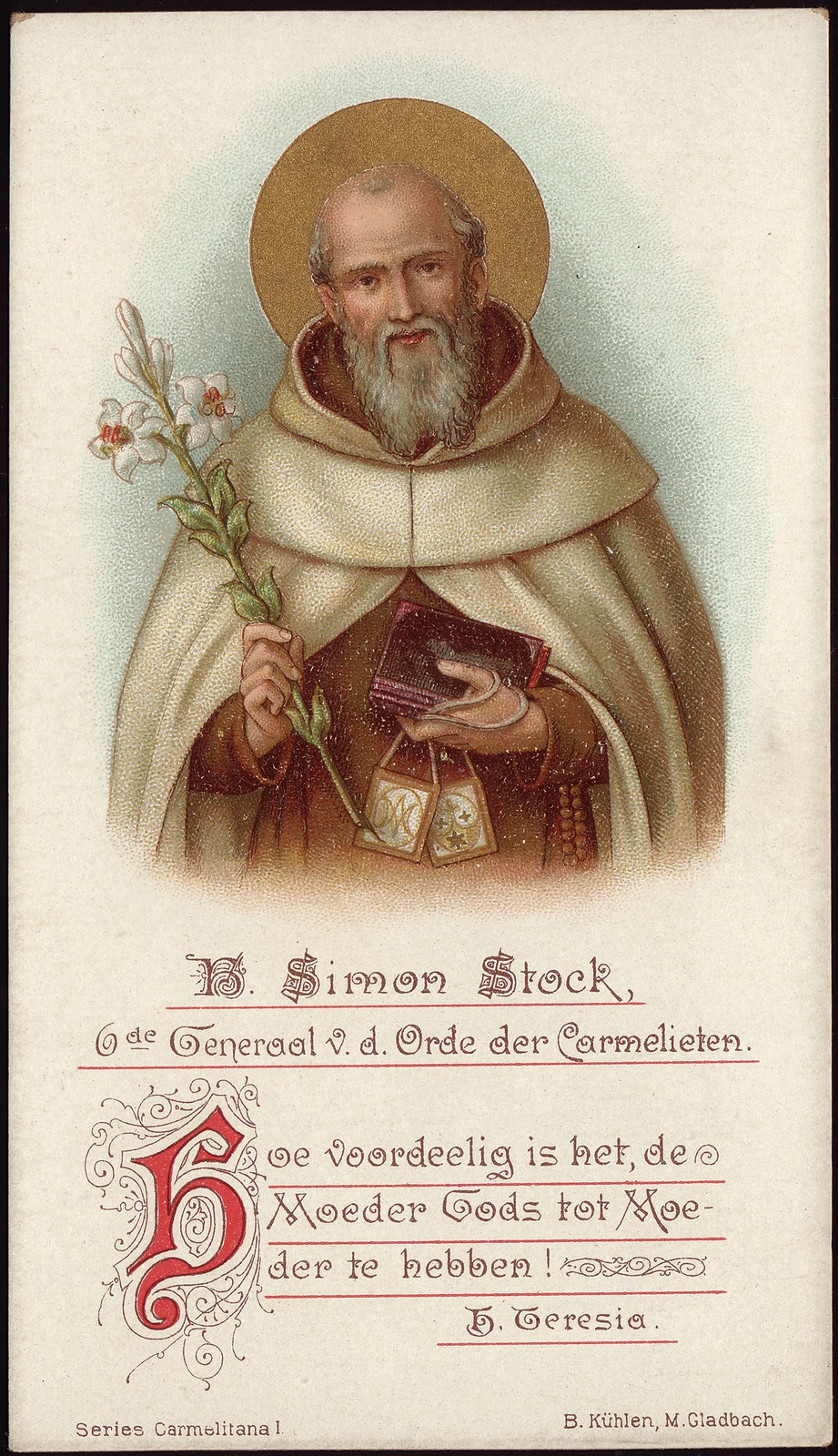The Brown Scapular is a Marian devotion which originated at about the same time as the Rosary, and like the Marian shrine at Walsingham, had its origin in England. In the thirteenth century, during the time of the Crusades, Simon Stock went on a pilgrimage to the Holy Land where he met a group of hermits on Mount Carmel. These claimed to be the successors of Elijah and his followers, and, attracted by their way of life, Simon returned with them to England when the situation became too dangerous in Palestine because of the Saracens.
They settled at Aylesford in Kent and in 1254 Simon was elected Superior-general of the now mendicant Carmelites, who were regarded somewhat like the other mendicant orders such as the Franciscans and Dominicans.
Simon founded other houses as the order began to grow but he faced many problems as the original 'solitary' ideal of the hermits changed towards the more communal approach of the mendicants. These weren't just internal problems, as older orders also resented the arrival of these newcomers with their own particular devotion to Mary.
Simon withdrew to his monastic room or 'cell' - probably at Cambridge by this time - to try and gain some relief from the problems faced both by himself and his Carmelite order, and in order to pray to Mary; it was then that he had his famous vision of her bringing the Brown Scapular to him with the following words, which are preserved in a fourteenth century narrative: "This will be for you and for all Carmelites the privilege, that he who dies in this will not suffer eternal fire.
The Scapular promise is based on the two elements of Mary's spiritual maternity and her mediation of grace, that is that she is the 'spiritual' mother of all mankind, as well as the 'channel' by which all grace comes to us, understood in the sense that she too is dependent on the sole mediation of Christ, her son.
This promise implies that Mary will intercede to ensure that the wearer of the Scapular obtains the grace of final perseverance, that is of dying in a state of grace. The modern Scapular consists of two pieces of brown rectangular cloth, roughly an inch by an inch and a half, which are usually decorated with appropriate Marian pictures, and are connected by two narrow brown cords, are worn around the neck and shoulders, hanging down to the front and back.
The Scapular promise has come in for criticism, on somewhat similar grounds to those argued against Walsingham, that is, a lack of early supporting documentation. However it seems that the above account was found in the earliest record of St Simon Stock's life, and it is unreasonable to expect written evidence from the thirteenth century, since the Carmelite order didn't produce much literature until it had grown somewhat larger in the mid-fourteenth century.
It was about this time that the wearing of the Scapular spread to the laity, and gradually over the centuries it has gained in popularity, particularly following promotion of the 'Sabbatine Privilege' by popes of the sixteenth and seventeenth centuries. This is an idea which probably grew out of a deepened understanding of the promise originally made to St Simon, and essentially involves the idea that Mary will intervene to help those who have worn the Scapular before death and now find themselves in purgatory, particularly on a Saturday, the day traditionally dedicated to Mary.
In order to be eligible for the Scapular promise, which is really a sign of consecration to Mary and hence to God, it is necessary for the wearer to have observed the virtue of chastity according to their state in life, whether married or single, and to have complied with the spirit of inner devotion which the wearing of the Scapular implies.
This is a devotion which has also been continually encouraged by more recent popes, and so it is not something which has lost its power, even if it may have become unfashionable in some circles. If, as in the case of the Rosary, a whole series of popes, have, by virtue of their unique position of authority, approved the Scapular devotion, then clearly it just cannot be dismissed out of hand, at least not by Catholics who take the teaching and pastoral authority of the Church seriously. There is also an emphasis on the Scapular in the apparitions at Fatima which means it retains its relevance for today.
Sources: Farmer, The Oxford Dictionary of Saints; Carol, Mariology, Vol. 3
Great talk on the scapular, HERE.





















2 comments:
I have been reading your post and am slowly visiting the rest of your blog. God Bless you for all of your efforts to spread the Good News of the One, Holy, Catholic & Apostolic Faith. I am not big on 'awards', but I am extending this one as an extension of my support and Catholic friendship, as was given to me by Jean@Catholic Fire:
http://aszat.wordpress.com/2010/05/15/sunshine-award/
God Bless! - Adrienne
Thank you, Adrienne, how kind of you!
Post a Comment